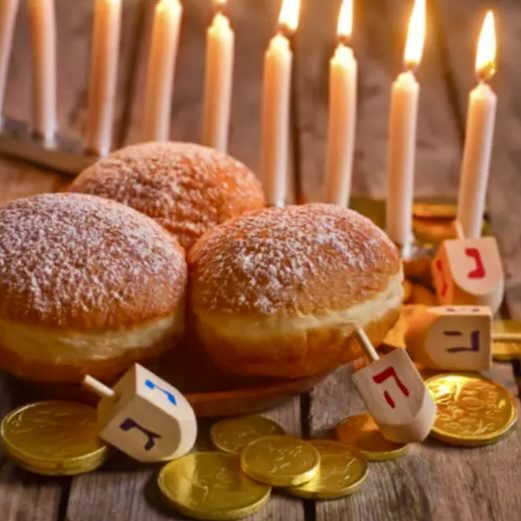Chanukah 2025 / חֲנוּכָּה 5786
Hanukkah, the Jewish festival of rededication 🕎
Chanukah for Hebrew Year 5786 begins at sundown on Sunday, 14 December 2025 and ends at nightfall on Monday, 22 December 2025.
HANUKKAH is celebrated for eight days. Hanukkah reaffirms the ideals of Judaism and commemorates in particular the rededication of the Second Temple of Jerusalem by the lighting of candles on each day of the festival. Although not mentioned in the Hebrew Scriptures, Hanukkah came to be widely celebrated and remains one of the most popular Jewish religious observances.
Hanukkah (Hebrew: חֲנֻכָּה, usually spelled חנוכה pronounced [χanuˈka] in Modern Hebrew, also romanized as Chanukah or Chanuka), also known as the Festival of Lights, is an eight-day Jewish holiday commemorating the rededication of the Holy Temple (the Second Temple) in Jerusalem at the time of the Maccabean Revolt of the 2nd century BCE. Hanukkah is observed for eight nights and days, starting on the 25th day of Kislev according to the Hebrew calendar, which may occur at any time from late November to late December in the Gregorian calendar.
Origin and history:
Hanukkah commemorates the Maccabean (Hasmonean) victories over the forces of the Seleucid king Antiochus IV Epiphanes (reigned 175–164 BCE) and the rededication of the Temple on Kislev 25, 164 BCE. Led by Mattathias and his son Judas Maccabeus (died c. 161 BCE), the Maccabees were the first Jews who fought to defend their religious beliefs rather than their lives. According to I Maccabees, a text of the Apocrypha (writings excluded from the Jewish canon but included in the Roman Catholic and Eastern Orthodox Old Testament canons), Antiochus had invaded Judaea, tried to Hellenize the Jews, and desecrated the Second Temple in Jerusalem. Following the Jewish victory in a three-year struggle against Antiochus, Judas ordered the cleansing and restoration of the Temple.
Modern popularity
Hanukkah has traditionally been considered a relatively minor holiday, compared with the major festivals of Passover, Purim, Rosh Hashanah, and Yom Kippur. A shift toward its modern popularity and prominence began in the mid-19th century, particularly in the United States. Scholars point to the efforts of the Cincinnati-based Reform Judaism rabbis Isaac Wise and Max Lilienthal, who noted that Christmas, which occurs about the same time as Hanukkah, was particularly popular with children. The rabbis began to remake Hanukkah as a fun and engaging holiday to excite children and increase synagogue attendance. The opportunity to celebrate a holiday about the same time as Christmas allowed American Jews to maintain their unique identity while also participating in winter festivities. The novel importance of Hanukkah soon spread from Reform Judaism to other branches of the tradition. As Christmas increasingly became commercialized in the early 20th century, Jews began to add to Hanukkah various Christmas-like traditions in parallel, such as gift giving, new joyful songs, and festive Hanukkah-themed decorations.
Happy Hanukkah
Traditions
The celebration of Hanukkah includes a variety of religious and nonreligious customs. Like Purim, Hanukkah is a joyous festival that lacks the work restrictions characteristic of the major festivals of Rosh Hashanah and Yom Kippur.
Menorah
The lighting of a menorah for each of the eight days of Hanukkah.
The most important of all Hanukkah traditions is the lighting each evening of a special nine-branched candelabra called a ḥanukkiyah, which is a type of menorah. A menorah is a traditional seven-branched candelabra used in the Temple of Jerusalem and a potent symbol in Judaism. To represent the miracle of one day’s worth of oil burning for eight days, the Hanukkah menorah has eight branches for candles plus a holder for the shammash (“servant”) candle. The shammash candle is used to light the other eight candles, and its holder is typically offset higher than the others. Styles for Hanukkah menorahs vary widely from simple to elaborate, traditional to modern, and there are also electric versions.
One candle is lit on the first evening, and an additional candle is lit on each subsequent evening until eight candles are burning on the last evening. Olive oil was traditionally used for lighting the menorah, but it was replaced by candles, which are inserted in the menorah incrementally each night of the festival from right to left but are lit from left to right. The Hanukkah candles are lit after sundown, except on the Sabbath; because of the prohibition on lighting a fire during the Sabbath, they are lit before the Friday-evening Sabbath candles. Blessings are also offered after the candles have been arranged in their places and while holding the lit shammash prior to using it to light the other candles. Two blessings are sung each night, and a third is added on the first night. The menorah was originally kindled outside the home, with the intention of publicizing the miracle, but it was brought inside in ancient times to guard against danger or offending neighbors. It is frequently lit in a home’s window.
Liturgy and prayers
The Hanukkah observance is also characterized by the daily reading of Scripture, recitation of some of the Psalms, almsgiving, and singing of a special hymn. The liturgy includes Hallel, public readings from the Torah, and the ʿal ha-nissim (“for the miracles”) prayer. The Scroll of Antiochus, an early medieval account of Hanukkah, is read in some synagogues and homes. Along with the daily prayers, thanks are offered to God for delivering the strong into the hands of the weak and the evil into the hands of the good. The word Hanukkah in Hebrew also means “education,” and rabbis and Jewish educators try to instill in their congregants and students the notion that the holiday celebrates Jewish strengths, perseverance, and continuity.
